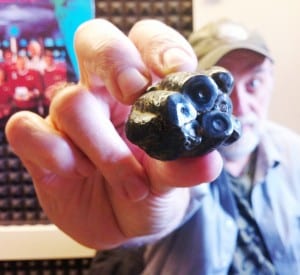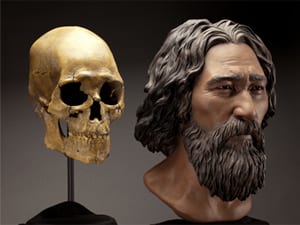
KRBD Radio reporter Leila Kheiry covered the research of SMU paleontologist Louis L. Jacobs, a professor in the Roy M. Huffington Department of Earth Sciences, Dedman College of Humanities and Sciences and paleontologist Anthony Fiorillo, vice president of research and collections and chief curator at the Perot Museum of Nature and Science, Dallas, and an adjunct research professor at SMU.
Jacobs and Fiorillo are co-authors of a study about the identification of new fossils from the oddball creature Desmostylia, discovered in the same waters where the popular “Deadliest Catch” TV show is filmed. The hippo-like creature ate like a vacuum cleaner and is a new genus and species of the only order of marine mammals ever to go extinct — surviving a mere 23 million years.
The KRBD coverage was included in a piece about Ketchikan artist Ray Troll, who contributed illustrations of the new species.
Troll is the artist who has most illustrated desmostylians, prompting Jacobs to dub a “group” of desmostylians a “troll.” KRBD is the Ketchikan FM community radio covering southern southeast Alaska.
[/fusion_builder_column][fusion_builder_column type=”1_1″ background_position=”left top” background_color=”” border_size=”” border_color=”” border_style=”solid” spacing=”yes” background_image=”” background_repeat=”no-repeat” padding=”” margin_top=”0px” margin_bottom=”0px” class=”” id=”” animation_type=”” animation_speed=”0.3″ animation_direction=”left” hide_on_mobile=”no” center_content=”no” min_height=”none”]

Desmostylians, every single species combined, lived in an interval between 33 million and 10 million years ago. Its strange columnar teeth and odd style of eating don’t occur in any other animal, Jacobs said. The new specimens — from at least four individuals — were recovered from Unalaska, an Aleutian island in the North Pacific.
Jacobs and Fiorillo reported their discovery in a special volume of the international paleobiology journal, Historical Biology. The article published online Oct.1 at http://bit.ly/1PQAHZJ.
The KRBD story aired Oct. 21, 2015.
EXCERPT:
By Leila Kheiry
KRBD Radio
Paleontologists recently announced the discovery of a new species of prehistoric marine mammal, found in Unalaska. While the fossils were discovered many years ago, the announcement in early October that they were of a separate species was new information.Ketchikan artistand self-described paleo-nerd Ray Troll had an inside line on the story, and contributed illustrations of the new species for the scientists.
Ray Troll has made a name for himself among the nerdy set with his scientifically accurate paintings, most often depicting fish and, more recently, extinct creatures known only by the fossils they’ve left behind.
Troll arrived at the station carrying a fossil that someone gave him many years ago in Oregon. Troll said that person thought it was a fossilized tooth from an ancient horse.
“Twenty-some years later, I start getting interested in this animal, and I was literally sitting there, googling Desmostylus tooth, looking at them on eBay, and I looked over and said, ‘I’ve got one! That’s what that is! It’s not a horse tooth!’”
The tooth is an odd-shaped square, a little more than an inch on each side. It’s made up of columns, each about the width of a pencil, and one edge of the tooth is worn smooth. Troll said Desmostylia’s name comes from its unusual dental development.
“Desmo means a bundle, it’s Latin for bundle. Stylus means a pillar,” he said. “So, it’s a bundle of pillars. It looks like a little six-pack.”
Desmostylia lived for about 23 million years, and then just died out, leaving behind its fossils.
“They’re found in the Pacific. The north Pacific, to be specific. Ba-dum-bump,” Troll said. “They range from the tip of Baha all the way over to Japan.”
Troll said he became interested in Desmos through his friend, Kirk Johnson, who worked with Troll on a book, “Cruisin’ the Fossil Freeway.”
Johnson was the connection between Troll and Dr. Louis Jacobs, a Texas paleontologist and one of the researchers who determined that the Unalaska fossils were a previously unidentified species.
Jacobs said he had been at the Smithsonian, looking at Desmostylian skeletons, and was about to leave for the day.
“And then, there was the Director of the National Museum of Natural History, Kirk Johnson, coming in,” Jacobs said. “We shook hands and said hello, and he asked me what I was doing. I told him, looking as Desmostylians. He said, ‘I love Desmostylians!’ he said, ‘Ray Troll and I are working on those things now, because we’re doing another book.’”
Follow SMUResearch.com on twitter at @smuresearch.
SMU is a nationally ranked private university in Dallas founded 100 years ago. Today, SMU enrolls nearly 11,000 students who benefit from the academic opportunities and international reach of seven degree-granting schools. For more information see www.smu.edu.
SMU has an uplink facility located on campus for live TV, radio, or online interviews. To speak with an SMU expert or book an SMU guest in the studio, call SMU News & Communications at 214-768-7650.

 $3.78 million awarded by Department of Defense to SMU STEM project for minority students
$3.78 million awarded by Department of Defense to SMU STEM project for minority students Kennewick Man: genome sequence of 8,500-year-old skeleton solves scientific controversy
Kennewick Man: genome sequence of 8,500-year-old skeleton solves scientific controversy At peak fertility, women who desire to maintain body attractiveness report they eat less
At peak fertility, women who desire to maintain body attractiveness report they eat less SMU seismology team to cooperate with state, federal scientists in study of May 7 Venus, Texas earthquake
SMU seismology team to cooperate with state, federal scientists in study of May 7 Venus, Texas earthquake